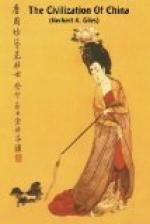Her features are fixed and calm, though myriad tears fall, Wetting a spray of pear-bloom, as it were with the raindrops of spring. Subduing her emotions, restraining her grief, she tenders thanks to His Majesty. Saying how since their parting she had missed his form and voice; And how, although their love on earth had so soon come to an end, The days and months among the Blest were still of long duration. And now she turns and gazes towards the above of mortals, But cannot discern the Imperial city, lost in the dust and haze. Then she takes out the old keepsake, tokens of undying love, A gold hairpin, an enamel brooch, and bids the magician carry these back. One half of the hairpin she keeps, and one half of the enamel brooch, Breaking with her hands the yellow gold, and dividing the enamel in two. “Tell him,” she said, “to be firm of heart, as this gold and enamel, And then in heaven or on earth below we two may meet once more.”
The magnificent House of T’ang was succeeded by five insignificant dynasties, the duration of all of which was crowded into about half a century. Then, in A.D. 960, began the rule of the Sungs (pronounced Soongs), to last for three hundred years and rival in national peace and prosperity any other period in the history of China. The nation had already in a great measure settled down to that state of material civilization and mental culture in which it has remained to the present time. To the appliances of ordinary Chinese life it is probable that but few additions have been made since a very early date. The dress of the people has indeed undergone several variations, but the ploughs and hoes, the water-wheels and well-sweeps, the tools of the artisans, mud huts, carts, junks, chairs, tables, chopsticks, etc., which we still see in China, are probably very much those of two thousand years ago. Mencius, of the third century B.C., observed that written characters had the same form, and axle-trees the same breadth, all over the empire; and to this day an unaltering uniformity is one of the chief characteristics of the Chinese people in every department of life.
In spite, however, of the peaceful aspirations of the House of Sung, the Kitan Tartars were for ever encroaching upon Chinese territory, and finally overran and occupied a large part of northern China, with their capital where Peking now stands. This resulted in an amicable arrangement to divide the empire, the Kitans retaining their conquests in the north, from which, after about two hundred years, they were in turn expelled by the Golden Tartars, who had previously been subject to them.
Many volumes, rather than pages, would be required to do justice to the statesmen, soldiers, philosophers, poets, historians, art critics, and other famous men of this dynasty. It has already been stated that the interpretation of the Confucian Canon, accepted at the present day, dates from this period; and it may now be of interest to give a brief account of another remarkable movement connected with the dynasty, though in quite a different line.




